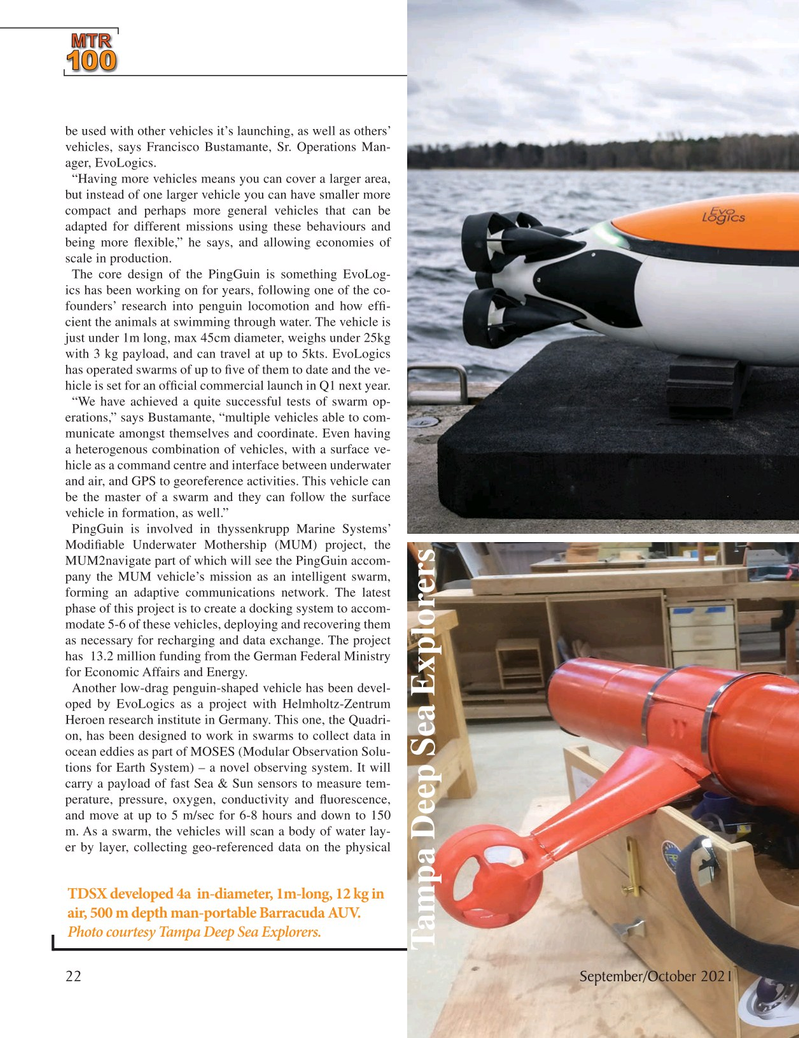
Page 22: of Marine Technology Magazine (September 2021)
MTR100: Focus on 100 Leading Companies, People and Innovations in the Subsea Space
Read this page in Pdf, Flash or Html5 edition of September 2021 Marine Technology Magazine
MTTTTTTTTTTTTTRM M M M M M M M M M M M M M M M M M M M M M M M M M M M MTRRRRRRRRRRRRRRRRRRRRRRRRRRRMTTTTTTTTTTTTTRMTR 100000000000000001111111111111111111111111111100000000000000000000000000000010000000000000000100 be used with other vehicles it’s launching, as well as others’ vehicles, says Francisco Bustamante, Sr. Operations Man- ager, EvoLogics. “Having more vehicles means you can cover a larger area, but instead of one larger vehicle you can have smaller more compact and perhaps more general vehicles that can be adapted for different missions using these behaviours and being more ? exible,” he says, and allowing economies of scale in production.
The core design of the PingGuin is something EvoLog- ics has been working on for years, following one of the co- founders’ research into penguin locomotion and how ef? - cient the animals at swimming through water. The vehicle is just under 1m long, max 45cm diameter, weighs under 25kg with 3 kg payload, and can travel at up to 5kts. EvoLogics has operated swarms of up to ? ve of them to date and the ve- hicle is set for an of? cial commercial launch in Q1 next year. “We have achieved a quite successful tests of swarm op- erations,” says Bustamante, “multiple vehicles able to com- municate amongst themselves and coordinate. Even having a heterogenous combination of vehicles, with a surface ve- hicle as a command centre and interface between underwater and air, and GPS to georeference activities. This vehicle can be the master of a swarm and they can follow the surface vehicle in formation, as well.”
PingGuin is involved in thyssenkrupp Marine Systems’
Modi? able Underwater Mothership (MUM) project, the
MUM2navigate part of which will see the PingGuin accom- pany the MUM vehicle’s mission as an intelligent swarm, forming an adaptive communications network. The latest phase of this project is to create a docking system to accom- modate 5-6 of these vehicles, deploying and recovering them as necessary for recharging and data exchange. The project has 13.2 million funding from the German Federal Ministry for Economic Affairs and Energy.
Another low-drag penguin-shaped vehicle has been devel- oped by EvoLogics as a project with Helmholtz-Zentrum
Heroen research institute in Germany. This one, the Quadri- on, has been designed to work in swarms to collect data in ocean eddies as part of MOSES (Modular Observation Solu- tions for Earth System) – a novel observing system. It will carry a payload of fast Sea & Sun sensors to measure tem- perature, pressure, oxygen, conductivity and ? uorescence, and move at up to 5 m/sec for 6-8 hours and down to 150 m. As a swarm, the vehicles will scan a body of water lay- er by layer, collecting geo-referenced data on the physical
TDSX developed 4a in-diameter, 1m-long, 12 kg in air, 500 m depth man-portable Barracuda AUV.
Photo courtesy Tampa Deep Sea Explorers.
Tampa Deep Sea Explorers 22 September/October 2021
MTR #7 (18-33).indd 22 9/21/2021 8:29:23 AM

 21
21

 23
23
